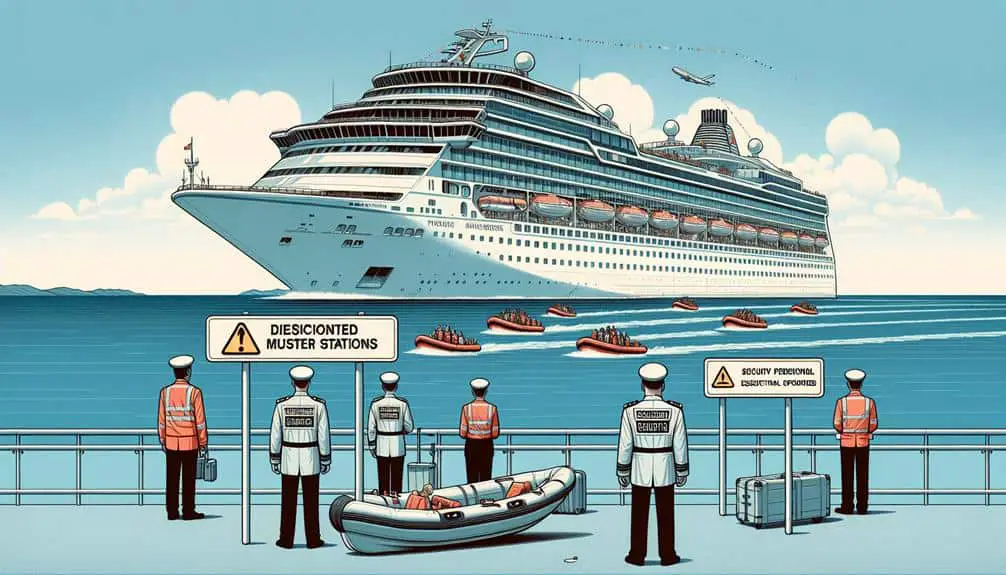Improve ship safety with surveillance cameras, emergency response plans, passenger safety drills, security personnel training, access control systems, fire safety measures, man overboard detection, alarm systems, crew training, medical facilities, cybersecurity, and lifeboat drills for thorough protection. Each measure plays a crucial role in safeguarding passengers and crew. By implementing these top security measures, vessels are better equipped to handle any emergency efficiently. Mastering these strategies guarantees a strong safety framework for all onboard. Explore the detailed explanations behind these top safety and security measures to strengthen your ship's protection.
Key Points
- Utilize surveillance cameras with legal advice for proper placement.
- Develop comprehensive emergency response plans and conduct regular drills.
- Train security personnel in threat assessment and emergency response.
- Enhance security with access control systems like keycards and biometrics.
- Install and maintain efficient fire suppression equipment for safety.
Surveillance Cameras
Guarantee your vessel's safety and security by strategically placing surveillance cameras throughout key areas onboard. When implementing surveillance cameras on a ship, it's important to take into account both privacy concerns and legal implications.
Privacy concerns arise due to the constant monitoring of individuals in enclosed spaces. To address this, make sure that cameras aren't placed in private areas such as bathrooms or crew cabins, respecting the privacy of those onboard.
Moreover, understanding the legal implications is essential. It's critical to comply with maritime laws and regulations regarding the use of surveillance cameras onboard. Failure to do so can result in legal consequences and potential liabilities.
Hence, consult legal experts to ensure that the placement and usage of surveillance cameras adhere to all relevant laws.
Emergency Response Plans
To guarantee the safety and security of your vessel, thorough Emergency Response Plans must be developed and implemented.
Emergency evacuation procedures need to be meticulously outlined in these plans. This includes designated assembly points, evacuation routes, and procedures for assisting individuals with disabilities.
Crisis communication strategies are also an essential component. Establishing clear lines of communication during emergencies is critical for coordinating response efforts and ensuring the safety of all individuals on board. This involves utilizing various communication methods such as public address systems, emergency alarms, and digital communication channels.
Additionally, assigning specific roles and responsibilities to crew members during emergency situations is crucial. Designating individuals to oversee evacuation procedures, communication protocols, and emergency equipment can help streamline response efforts and minimize confusion.
Regular training and drills should be conducted to ensure all crew members are familiar with their roles and can effectively respond to emergencies. By implementing detailed Emergency Response Plans, you can enhance the safety and security of your vessel and protect the well-being of everyone on board.
Passenger Safety Drills
Passengers on board must actively participate in safety drills to familiarize themselves with emergency procedures and guarantee preparedness in the event of a crisis. During these drills, you'll be instructed on the location and proper use of safety equipment such as life jackets, lifeboats, and emergency exits. Understanding the evacuation procedures is essential for your safety and the safety of others in case of an emergency.
Safety drills are an integral component of ship safety protocols. By participating attentively, you confirm that you're well-prepared to respond effectively in emergency situations. Pay close attention to instructions regarding evacuation routes, assembly points, and the roles each passenger should fulfill during an evacuation. These drills are designed to instill confidence and readiness in passengers, enabling a swift and organized response when needed.
Security Personnel Training
As security personnel on board a ship, your training focuses on developing expertise in threat assessment and mastering emergency response protocols. You're equipped to analyze potential risks and respond swiftly and effectively in crisis situations.
Through rigorous training, you become an integral part of ensuring the safety and security of all passengers and crew members on the vessel.
Expertise in Threat Assessment
With a focus on enhancing security measures aboard ships, security personnel undergo rigorous training to develop expertise in threat assessment. Threat mitigation strategies are ingrained through simulation exercises and scenario-based training.
Risk assessment techniques form a fundamental part of their learning, enabling them to identify vulnerabilities and potential security breaches proactively. Security personnel are trained to analyze threats systematically, considering various factors such as location, current events, and historical data.
They learn to assess the credibility and severity of threats swiftly, allowing for prompt decision-making and response. Through continuous training and exposure to evolving security challenges, these professionals hone their skills in threat assessment, ensuring that ships are well-protected against potential risks.
Emergency Response Protocols
Effective implementation of emergency response protocols is integral to security personnel training aboard ships. Security personnel are trained in emergency evacuation procedures to guarantee a swift and organized response in times of crisis. This training includes mastering communication protocols to relay essential information effectively during emergencies.
Crisis management techniques are also a key component of security personnel training, equipping them with the skills needed to handle various incidents that may arise on board. Incident response training focuses on quick decision-making, coordination with other crew members, and ensuring the safety and security of all passengers and crew.
Access Control Systems
Implementing advanced access control systems enhances the security measures onboard a ship by regulating entry and monitoring personnel movements. These systems are essential for maintaining access control effectiveness and preventing security breaches. Access control systems utilize various technologies such as keycard access, biometric scanners, and PIN codes to restrict entry to authorized personnel only. By requiring unique identifiers for access, these systems guarantee that only approved individuals can enter sensitive areas of the ship.
Moreover, access control systems help in tracking and monitoring personnel movements throughout the ship. In the event of a security breach, these systems provide real-time data on who accessed certain areas, aiding in investigations and response efforts. By restricting unauthorized access, these systems play a key role in preventing incidents such as theft, sabotage, or unauthorized entry to critical ship systems.
Fire Suppression Equipment
Enhancing ship safety and security further, the installation of efficient fire suppression equipment is paramount for safeguarding against potential onboard fires. Proper maintenance of fire suppression equipment is essential to guarantee its functionality in case of emergencies. Regular inspections, testing, and adherence to manufacturer guidelines are vital to keep the equipment in top-notch condition.
In addition to maintenance, regulatory compliance is a key aspect of fire suppression equipment onboard. Ships must meet stringent regulations set forth by organizations like the International Maritime Organization (IMO) and the International Convention for the Safety of Life at Sea (SOLAS). These regulations specify the type of fire suppression systems required, installation standards, and periodic inspections to ensure compliance and readiness.
Man Overboard Detection
When considering man overboard detection on ships, it's essential to explore the sensor technology overview to understand how these systems operate. Implementing alarm systems that can quickly alert the crew of a person falling overboard is key for rapid response.
Ensuring that the crew receives thorough training on how to respond to man overboard situations is critical for the effective use of these detection measures.
Sensor Technology Overview
Utilizing advanced sensor technology, man overboard detection systems play an essential role in enhancing ship safety and security measures. Sensor technology advancements have led to more efficient systems that can quickly detect when a person falls overboard.
These cost-effective sensor solutions are designed for easy implementation on various types of vessels. By utilizing sensors that can detect changes in the water, such as temperature or pressure variations caused by a person entering the water, these systems can trigger alarms and alert crew members promptly.
The implementation of these sensor technologies has notably improved response times in man overboard situations, allowing for quicker rescue operations and ultimately enhancing overall safety measures on ships.
Alarm System Implementation
Implementing an advanced alarm system for man overboard detection is crucial in enhancing ship safety and security measures.
To prevent security breaches and guarantee effective risk assessment, the alarm system must be integrated with robust intrusion detection capabilities.
By incorporating state-of-the-art sensors and safety protocols, the alarm system can quickly identify and alert crew members of a potential man overboard situation.
This advanced technology not only aids in early detection but also streamlines response times, allowing for swift and coordinated rescue operations.
Essentially, the alarm system serves as a critical component in the overall safety and security framework of a ship, providing proactive measures to mitigate risks and enhance onboard emergency preparedness.
Crew Training Importance
To ensure effective man overboard detection, thorough crew training is essential in mastering the operation of the advanced alarm system onboard.
Crew members must engage in role-playing scenarios and interactive training sessions to understand the intricacies of the system fully.
Simulation exercises provide hands-on practice, allowing the crew to familiarize themselves with different alarm responses and emergency protocols.
By actively participating in these training methods, crew members can enhance their reaction times and decision-making skills when faced with a real man overboard situation.
The effectiveness of man overboard detection greatly relies on the crew's ability to swiftly and accurately respond to alarms, making in-depth training an important component of ship safety and security.
Medical Facilities on Board
Onboard vessels, medical facilities are equipped to provide essential healthcare services for passengers and crew members in case of emergencies. Medical staff training guarantees that onboard healthcare services meet high standards. The medical staff, including doctors and nurses, undergo rigorous training to handle a wide range of medical situations efficiently. They're well-versed in basic first aid, CPR, and managing more serious conditions until further assistance or evacuation can be arranged.
Medical facilities on ships are typically equipped with essential medical supplies, diagnostic equipment, and medications to address common health issues promptly. These facilities can handle minor injuries, seasickness, and other medical concerns that may arise during the voyage. In more serious cases, ships have the capability to contact shoreside medical professionals for guidance or arrange for medical evacuation if needed.
Passengers and crew can rest assured that cruise ships prioritize the well-being of everyone on board by providing all-encompassing medical facilities and trained staff to ensure a safe and secure journey.
Cybersecurity Protocols
Ensuring the safety of digital systems onboard vessels, stringent cybersecurity protocols are established to safeguard against potential cyber threats and breaches. When it comes to cybersecurity on ships, several key measures are put in place to protect data and prevent unauthorized access.
- Risk Mitigation Strategies: Ship operators implement thorough risk mitigation strategies to identify, assess, and address potential cybersecurity risks. This includes conducting regular risk assessments and developing contingency plans to mitigate the impact of cyber threats.
- Data Protection: Data encryption, secure authentication methods, and access controls are essential to safeguarding sensitive information on ship networks. Regular data backups and secure data storage practices are also vital components of data protection measures.
- Ship Networks: Segmentation of ship networks helps in isolating critical systems from less secure areas, reducing the risk of a widespread cyber-attack. Network monitoring tools are utilized to detect any suspicious activities and maintain the continuous integrity of the ship's digital infrastructure.
Lifeboat Drills and Inspections
Ship operators must meticulously conduct regular lifeboat drills and inspections to confirm the readiness and functionality of these critical emergency vessels. Lifeboat maintenance is paramount to make sure these vessels are prepared to be deployed swiftly and effectively in case of an emergency. Regular inspections should include checking the structural integrity of the lifeboats, ensuring all mechanical components are functioning correctly, and verifying the adequacy of emergency supplies onboard.
Safety equipment testing is an essential aspect of lifeboat drills and inspections. This testing involves examining the lifeboat's communication devices, navigation equipment, and emergency lighting to guarantee they're operational. Additionally, conducting drills to simulate emergency scenarios enhances crew members' familiarity with lifeboat procedures and increases response efficiency during real emergencies.
Frequently Asked Questions
How Often Are Surveillance Cameras Monitored on a Ship?
Surveillance cameras on ships are usually monitored 24/7. Security personnel undergo rigorous training to guarantee efficient monitoring and response. Regular checks and protocols are in place to maintain top-notch safety and security standards.
What Specific Training Do Security Personnel Receive to Handle Onboard Emergencies?
In handling onboard emergencies, security personnel receive specialized training in emergency response and crisis management. This includes drills, simulations, and knowledge of safety protocols to guarantee swift and effective action in critical situations.
Are There Any Specific Regulations Regarding Access Control Systems on Cruise Ships?
When it comes to access control systems on cruise ships, specific security regulations are in place to guarantee the safety of passengers and crew. These systems are designed to restrict unauthorized entry and monitor movements onboard.
How Often Are Lifeboat Drills and Inspections Conducted?
Lifeboat drills and inspections are conducted regularly on ships to guarantee safety. These drills are typically scheduled at least once every month to maintain proper readiness and compliance with safety regulations.
What Measures Are in Place to Protect the Ship From Cyber Attacks While at Sea?
To protect the ship from cyber attacks while at sea, sophisticated cyber security protocols are in place. Continuous onboard monitoring, firewalls, encryption, and regular vulnerability assessments guarantee robust defenses. Stay vigilant and report any suspicious activities promptly.




